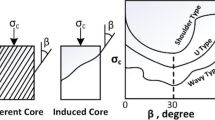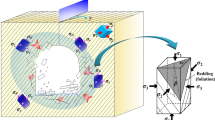Abstract
The anisotropy of schist usually has a complex influence on stability of tunnel surrounding rock. In this study, the schist anisotropy and its variation with the confining pressure are analyzed by the triaxial compression test. Then, geological models of tunnel under typical schistose angles α are established based on the highway tunnel project from Shiyan City to Fangxian County in China. Furthermore, the anisotropic failure mechanism, plastic zone distribution and displacement distribution of surrounding rock are investigated to understand its deformation and failure response pattern to the buried depth of tunnel and variable anisotropy. The results show that increased confining pressure weakens deformation anisotropy and weakly strengthens strength anisotropy of the schist. As the buried depth of tunnel changes from 60 to 140 m, the plastic morphology of surrounding rock with α = 0° presents a similar oval and it has a horizontal development trend. When α = 45°, it shows a spiral sector which has oblique extension as well as the increased angle θ between the long and short axis. While a cap shape with vertical development trend when α = 90°. With the weakening deformation anisotropy of surrounding rock, the anisotropic influence coefficient \(\gamma_{1}\) decreases gradually, indicating that schistose plane engenders a diminishing effect on the anisotropic deformation of surrounding rock as buried depth of tunnel increases.


















Similar content being viewed by others
References
Behrestaghi M, Rao KS, Ramamurthy T (1996) Engineering geological and geotechnical responses of schistose rocks from dam project areas in India. Eng Geol 44(1):183–201
Cui Z, Hou J, Sheng Q, Zhang W, Zhou Y (2015) A discussion on the numerical simulation of mechanical properties’anisotropy of Danba quartz mica schist. J Railw Sci Eng 12(5):1064–1073 (in Chinese)
Ghazvinian A, Vaneghi RG, Hadei MR, Azinfar MJ (2013) Shear behavior of inherently anisotropic rocks. Int J Rock Mech Min Sci 61:96–110
Guo SF, Qi SW, Huang XL (2013) Anisotropy of rock mass strength and its transformation critical confining stress. Chin J Rock Mech Eng 32:3222–3227 (in Chinese)
Huang SL, Ding XL, Liao CG, Wu AQ, Yin JM (2014) Initial 3d geostress field recognition of high geostress field at deep valley region and considerations on underground powerhouse layout. Chin J Rock Mech Eng 33(11):2210–2224 (in Chinese)
Jia SP, Luo J, Wu B, Wu GJ (2013) Stability analysis of surrounding rock of tunnel based on anisotropic constitutive model. Water Resour Power 31(9):111–114 (in Chinese)
Kim H, Cho JW, Song I, Min KB (2012) Anisotropy of elastic moduli, P-wave velocities, and thermal conductivities of Asan Gneiss, Boryeong Shale, and Yeoncheon Schist in Korea. Eng Geol 147:68–77
Li XH, Xia BW, Li D, Han CR (2010) Deformation characteristics analysis of layered rockmass in deep buried tunnel. Rock Soil Mech 31(4):1163–1167 (in Chinese)
Li DY, Wong LNY, Liu G, Zhang X (2012) Influence of water content and anisotropy on the strength and deformability of low porosity meta-sedimentary rocks under triaxial compression. Eng Geol 126:46–66
Lin CD (1999) Procedure analysis of numerical simulation for the failure mechanism of laminate roof. Chin J Rock Mech Eng 18(4):392–396 (in Chinese)
Liu SL, Chen SX, Yu F, Zhao WG (2012) Anisotropic properties study of chlorite schist. Rock Soil Mech 33(12):3616–3623 (in Chinese)
Lokajíček T, Svitek T (2015) Laboratory measurement of elastic anisotropy on spherical rock samples by longitudinal and transverse sounding under confining pressure. Ultrasonics 56:294–302
Martínková M, Pros Z, Klíma K, Lokajíček T, Kotková J (2000) Experimentally determined P-wave velocity anisotropy for rocks related to the Western Bohemia seismoactive region. Stud Geophys Geod 44(4):581–589
Nadri D, Bóna A, Brajanovski M, Lokajíček T (2011) Estimation of stress-dependent anisotropy from P-wave measurements on a spherical sample. Geophysics 76(3):91–100
Nasseri MHB, Rao KS, Ramamurthy T (2003) Anisotropic strength and deformational behavior of Himalayan schists. Int J Rock Mech Min Sci 40(1):3–23
Niandou H, Shao JF, Henry JP et al (1997) Laboratory investigation of the mechanical behaviour of Tournemire shale. Int J Rock Mech Min Sci 34(1):3–16
Ramamurthy T, Rao GV, Singh J (1993) Engineering behaviour of phyllites. Eng Geol 33(3):209–225
Saeidi O, Rasouli V, Vaneghi RG (2014) A modified failure criterion for transversely isotropic rocks. Geosci Front 5(2):215–225
Song LT, Wang Y, Liu ZH, Wang Q (2015) Elastic anisotropy characteristics of tight sands under different confining pressures and fluid saturation states. Chin J Geophys 58(9):3401–3411 (in Chinese)
Sun GZ (1988) Rock mass structure mechanics. Science Press, Beijing
Tien YM, Kuo MC, Juang CH (2006) An experimental investigation of the failure mechanism of simulated transversely isotropic rocks. Int J Rock Mech Min Sci 43(8):1163–1181
Tiwari RP, Rao KS (2006) Deformability characteristics of a rock mass under true-triaxial stress compression. Geotech Geol Eng 24(4):1039–1063
Wang SH, Lee CI, Ranjith PG, Tang CA (2009) Modeling the effects of heterogeneity and anisotropy on the excavation damaged/disturbed zone (EDZ). Rock Mech Rock Eng 42(2):229–258
Wang SY, Sloan SW, Tang CA, Zhu WC (2012) Numerical simulation of the failure mechanism of circular tunnels in transversely isotropic rock masses. Tunn Undergr Space Technol 32:231–244
Wang ZQ, Yan EC, Liu YX, Wang ZJ (2014a) Anisotropic properties of deformation parameters and its mechanism of Wudang group schist. Rock Soil Mech 35(5):1317–1322 (in Chinese)
Wang ZQ, Yan EC, Huang XJ, Wang Q (2014b) Anisotropic and water sensitivity properties study of schist deformation parameters in northwest of Hubei province. Chin J Rock Mech Eng 33(A02):3967–3972 (in Chinese)
Yin XM, Yan EC, Cui XJ, Wang YC, Zhuo QF (2017) Characteristic of strength anisotropy and failure modes of schist. J Eng Geol 25(4):943–952 (in Chinese)
Zhang XM (2007) Anisotropic characteristics of rock material and its effect on stability of tunnel surrounding rock. Ph.D. thesis, Central South University, China
Zhang XP, Wong LNY, Wang SJ, Han GY (2011) Engineering properties of quartz mica schist. Eng Geol 121(3):135–149
Zhang Y, Xiao PX, Cheng LJ (2014) Method of layout design based on ratio of rock strength to in situ stress for large underground caverns. Chin J Rock Mech Eng 33(11):2314–2331 (in Chinese)
Zhao PL (1993) Anisotropy study on effect about compressive confining pressure strength of bedded rock. J Lanzhou Univ (Nat Sci) 29(1):105–109 (in Chinese)
Zhu ZQ, Sheng Q, Mei SH, Zhang ZR (2009) Improved ubiquitous-joint model and its application to underground engineering in layered rock masses. Rock Soil Mech 30(10):3115–3122 (in Chinese)
Acknowledgements
This research is financially supported by the Nanhu Scholars Program of Xinyang Normal University and the Natural Science Foundation of China (Grant No. 41807240).
Author information
Authors and Affiliations
Corresponding author
Additional information
Publisher's Note
Springer Nature remains neutral with regard to jurisdictional claims in published maps and institutional affiliations.
Rights and permissions
About this article
Cite this article
Yin, X., Yan, Ec. & Feng, B. Deformation and Failure Response Pattern of Schistosed Surrounding Rock to Its Anisotropic Properties. Geotech Geol Eng 37, 5131–5146 (2019). https://doi.org/10.1007/s10706-019-00967-1
Received:
Accepted:
Published:
Issue Date:
DOI: https://doi.org/10.1007/s10706-019-00967-1




